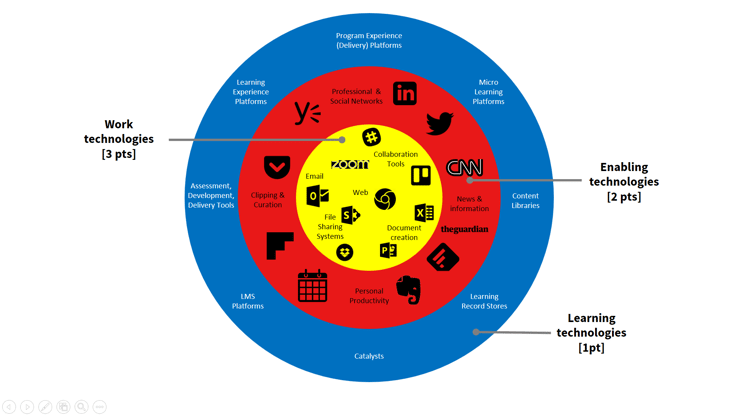There's something 'bout that work, work, work, work, work, work
When you a gon' learn, learn, learn, learn, learn, learn
— Rihanna
The relationship between work and learning is close, important, yet bizarrely confusing. People that work in learning technologies are often criticised for developing strategies which are too disconnected from actual work. So the learning doesn’t feel relevant, doesn’t happen or happens poorly. This is the entire basis of the 70:20:10 discussion. Such a simple pair of common words, used by 3 year olds. Why does the work-learn relationship spin us out like this?
Here’s an unscientific, but hopefully insightful, way of taking a look at learning in a literally work-centric way. Start with work technologies we all use every day (eg email and Slack) and place this in the middle. Around those add technologies which, though not essential, enable us to do our work better, like LinkedIn. Outside of these, add learning technologies (for which I’ve slightly adapted Josh Bersin’’s list). Note that none of these are specialist technologies technologies like SalesForce; these are technologies for the world’s knowledge workers, the LinkedIn set of half a billion, more or less.

I don’t claim that this is an exhaustive list of technologies or providers. Still, I think it’s helpful. It encourages L&D people to view themselves as being on the periphery of business and to force their way towards the centre which is, to borrow Slack’s tagline, where work happens.
And now a game to find out how relevant your learning strategy is to your business.
- Give yourself 1 point for every item (words, not the icons) in the blue outer circle meaningfully encompassed by your learning strategy.
- Give yourself 2 for the enablers you hit in the red ring.
- And three whole points for items in the yellow bullseye.
How many do you have? I’m told by my L&D friends that 20 is a very good score.
We’ve got hung up on this term ‘learning technologies’. But it’s more healthy and useful to think more widely about work technologies. Wrap your learning strategy around all that and learning will become more relevant.

